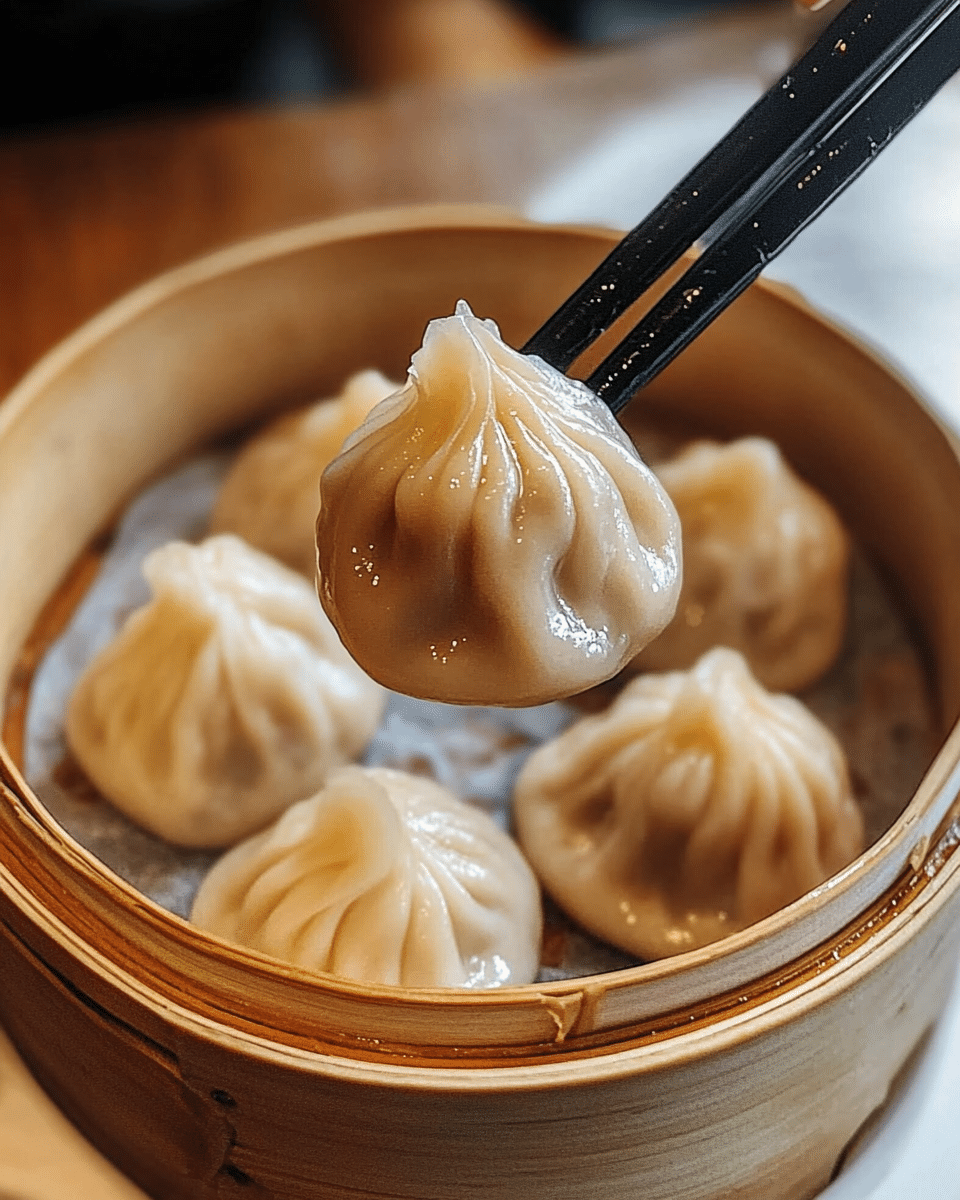The charm of soup dumplings, or Xiao Long Bao, lies in their delicate craftsmanship and the burst of hot, savory broth you experience with every bite. These little parcels of joy are a staple in Shanghai cuisine and loved all over the world for their intricate folds and deeply satisfying flavor.
While they may seem daunting at first, making soup dumplings at home is an achievable culinary project that pays off in spades. From preparing a rich pork aspic to kneading your own dough, every step is a labor of love that results in restaurant-quality dumplings right from your steamer basket. Serve them with a simple dip of black vinegar and fresh ginger to complete this authentic dining experience.
Full Recipe:
Ingredients:
For the Dough:
-
2 cups all-purpose flour
-
3/4 cup hot water
For the Aspic (Soup Gelatin):
-
1 lb pork skin or pork belly with skin
-
4 cups water
-
2 green onions
-
3 slices ginger
-
1 tbsp Shaoxing wine
For the Filling:
-
1 lb ground pork (preferably with at least 20% fat)
-
2 tbsp light soy sauce
-
1 tbsp Shaoxing wine
-
1 tsp sesame oil
-
1/2 tsp sugar
-
1/4 tsp white pepper
-
1 tsp grated ginger
-
1/2 cup minced green onion
-
1/2 tsp salt
-
1/2 cup prepared pork aspic, finely diced
Directions:
-
Make the Aspic: Simmer pork skin or pork belly in water with green onions, ginger, and Shaoxing wine for 2 hours. Strain and refrigerate until it sets into a jelly. Once set, finely dice the aspic.
-
Prepare the Dough: In a mixing bowl, add hot water gradually into the flour, stirring with chopsticks until crumbly. Knead into a smooth dough, cover, and rest for 1 hour.
-
Make the Filling: Combine ground pork with all filling ingredients except aspic. Stir until the mixture is sticky. Fold in the diced aspic gently.
-
Form the Dumplings: Divide dough into 24 pieces, roll each into a thin circle. Place a tablespoon of filling in the center and pleat to seal the top tightly.
-
Steam the Dumplings: Line a bamboo steamer with parchment or cabbage leaves. Steam dumplings over boiling water for 8 minutes.
-
Serve: Carefully transfer to a plate and serve hot with black vinegar and julienned ginger.
Prep Time: 1 hour | Cooking Time: 2 hours | Total Time: 3 hours
Kcal: 270 kcal | Servings: 4 servings (6 dumplings per person)
Xiao Long Bao (Soup Dumplings): A Culinary Labor of Love
When it comes to comforting Chinese dishes that captivate both the eyes and taste buds, Xiao Long Bao also known as soup dumplings, stand in a league of their own. These delicate steamed parcels are not your average dumpling. They’re a unique fusion of tender pork, rich broth, and delicate hand-rolled wrappers, expertly pleated to encase a little explosion of savory goodness. Originally hailing from Jiangnan, particularly in Shanghai and Suzhou, Xiao Long Bao has earned global fame, thanks to its intricate texture, rich flavor, and sheer delight it brings when the hot soup bursts in your mouth.
In Chinese culinary culture, the art of making dumplings especially Xiao Long Bao is not only about flavor but tradition, craftsmanship, and celebration. These soup dumplings are often made from scratch and served during Lunar New Year, family reunions, and festive banquets. They are commonly found in dim sum restaurants across Asia and Chinese communities worldwide, from Hong Kong and Taiwan to Los Angeles and London.
A Peek Into Xiao Long Bao’s History
The roots of Xiao Long Bao date back to the late 19th century in Nanxiang, a suburb of Shanghai. Legend has it that a tea house owner wanted to surprise his customers with something new and ingenious. He decided to incorporate a meat aspic into his dumpling filling. When steamed, the aspic melted into soup, offering a magical, flavorful surprise inside. Since then, these soup-filled dumplings became a signature item in Shanghai cuisine and are now internationally recognized as a beloved dim sum delicacy.
Despite their long history, Xiao Long Bao didn’t become widely known outside China until the 20th century, when Chinese immigration and the globalization of food culture brought them into the spotlight. Renowned restaurants such as Din Tai Fung played a key role in popularizing soup dumplings worldwide by emphasizing consistent quality and theatrical open-kitchen displays.
The Craftsmanship Behind the Dumplings
One of the main attractions of Xiao Long Bao is the technical skill required to make them. At first glance, they appear simple, yet every element demands precision:
-
The Wrapper must be thin enough to be almost translucent, yet strong enough to hold the meat and soup without breaking.
-
The Filling requires well-balanced seasoning and high-fat pork, usually from the shoulder or belly, to maintain juiciness and rich flavor.
-
The Aspic is the secret component that transforms the dumpling. Made from pork skin or bones simmered into a gelatinous broth, it’s cut into cubes and folded into the meat mixture. During steaming, it melts into a flavorful soup.
-
The Pleating is where artistry shines, expert chefs can fold 18-24 tiny pleats in each dumpling to create a classic, flower-like crown.
This culinary process makes Xiao Long Bao one of the most celebrated (and Instagrammed) dumplings in the world.
Ingredients That Matter
High-quality ingredients make a huge difference in this dish. Ground pork should have a fat content of at least 20% to ensure the filling is juicy and flavorful. The dough is typically a simple mixture of flour and hot water, which yields elasticity and strength once kneaded and rested. The aspic is made by simmering pork skin or pork bones for hours with aromatics like ginger, scallions, and Shaoxing wine. Once chilled, it becomes jelly-like and is diced into the filling.
Fresh ginger and green onion add brightness and depth to the meat, while soy sauce and Shaoxing wine offer umami complexity. A touch of sesame oil finishes off the savory aroma. Paired with a simple dipping sauce made from black vinegar and slivered ginger, the result is an unforgettable bite that balances richness with acidity.
Tools of the Trade
To make Xiao Long Bao at home, some specific tools help the process:
-
Bamboo Steamer: Essential for even steaming and traditional presentation.
-
Rolling Pin: A small Chinese-style pin without handles allows for precise dough control.
-
Silicone Mat or Parchment Paper: Prevents sticking inside the steamer basket.
-
Soup Spoon: Often served with a Chinese soup spoon to catch any dripping broth as diners bite into the dumpling.
While not mandatory, having these tools enhances the ease and enjoyment of the process.
Serving Suggestions
Xiao Long Bao is traditionally served fresh from the steamer, accompanied by black vinegar and ginger dipping sauce. The proper way to eat it? Carefully lift the dumpling using chopsticks and place it into a soup spoon. Poke a small hole with the tip of your chopsticks or bite a tiny corner to let the steam escape and slurp the broth. Then, dip it in vinegar, add some ginger, and savor the perfect balance of soup, meat, and dough.
These dumplings are often enjoyed as part of a dim sum spread, alongside other delights like siu mai, turnip cakes, and har gow. However, they can also be the star of the meal, served with a side of stir-fried vegetables or noodle soup for a more complete dinner.
Customizations & Variations
Though traditional Xiao Long Bao is filled with pork, variations exist:
-
Crab Roe Soup Dumplings: A luxurious version featuring crab meat and roe mixed with the pork filling.
-
Chicken Soup Dumplings: A lighter option that uses minced chicken and chicken aspic.
-
Vegetarian Dumplings: Filled with mushrooms, tofu, and vegetable aspic for a plant-based twist.
-
Spicy Dumplings: Some regional adaptations add chili oil or Sichuan pepper for an extra kick.
Modern food enthusiasts have even experimented with colorful wrappers using natural dyes from spinach, beetroot, or squid ink to give the dumplings visual flair.
Tips for Success
Making Xiao Long Bao at home may seem intimidating, but it’s absolutely doable with practice and patience. Here are some tips:
-
Chill the Filling: Cold filling is easier to handle and prevents the aspic from melting prematurely.
-
Work Fast: Once the wrappers are rolled out, fill and pleat them quickly to prevent drying.
-
Steam Immediately: Don’t let filled dumplings sit too long or the wrappers may weaken.
-
Keep the Dough Covered: Dry dough cracks easily and is difficult to seal.
Why Homemade Soup Dumplings Are Worth It
Sure, you can find Xiao Long Bao at your favorite dim sum restaurant or even in the frozen food aisle. But making them from scratch is a rewarding kitchen project that connects you with Chinese culinary traditions. It’s also a fun activity to do with friends or family, an afternoon of dumpling folding becomes a bonding experience filled with laughter, floury hands, and delicious results.
Homemade Xiao Long Bao also allows you to control the quality of ingredients, avoid additives, and tweak flavors to your liking. Whether you’re a seasoned cook or a curious food lover, there’s immense joy in mastering a dish as beloved and delicate as soup dumplings.
Conclusion
Xiao Long Bao is more than just a dish, it’s a testament to the depth and refinement of Chinese cuisine. From its humble origins in a Shanghai suburb to global dim sum stardom, soup dumplings continue to enchant diners with their technical brilliance and unforgettable flavor. Making them at home takes time and care, but the result is nothing short of magical: soft dough, savory filling, and that hot burst of soup that makes every bite special.
So if you’ve been intimidated by the idea of making soup dumplings from scratch, don’t be. Embrace the process, take it one pleat at a time, and prepare to impress yourself and your guests with one of China’s most iconic comfort foods. The journey is deliciously worth it.






